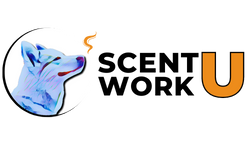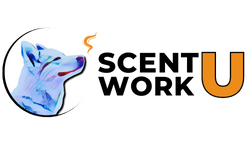It's Scent Work, Not Stuff Work!

As one progresses through Scent Work, it is commonplace to see patterns in where hides are placed, both in training and at trial. Falling into patterns like these is human nature! However, this is NOT the spirit in which the game of Scent Work should be played.
WHAT YOU PRACTICE MATTERS
“My dog is finding odor! What difference does it make?!”
Can you guarantee that your dog understands the game is truly about odor alone and not odor + tables, odor + chairs or odor + (enter item)?
“Ummm…”
I appreciate your honesty.
We must understand that our dogs are GUESSING what the game is all about based on two things: the picture we present to them and what they are rewarded for. Therefore, it is entirely possible for our dogs to come away from a training session thinking the game is about checking items for odor. However, this conclusion is incorrect! Our dogs should be searching the entirety of the space, not merely the “stuff” within it!
If your dog has only ever found hides inside or on items, they quite literally have no reason to think odor can be somewhere else. Besides their expectations, they also lack the experiential learning to recognize how those odor puzzles may look or how to solve them.
Here is a plainer way of putting this: if your dog has never seen an “area hide”, they may very well be unable to determine how to solve that problem.
I have witnessed this firsthand in extremely experienced dogs. Set an item hide and they can sort out the problem no problem. Place an area hide and they are fixated on checking the items in the space, and oftentimes extremely specific types of items (tables, chairs, etc.), getting flustered and frustrated when they keep coming up empty.
So, where you choose to place your hides and how you practice in training makes a HUGE difference in your dog’s ability to be successful.
BETTER WAYS TO PRACTICE
It is one thing for me to harp on and on about what I DO NOT want you to do. It is something else entirely to give you some ideas of what I WANT you to do.
My biggest piece of advice is to design your Scent Work training sessions to help your dog focus on odor and avoid them making other misleading assumptions. This requires that you be creative and look at each potential search area for obvious “stuff” placements and purposefully set less obvious “area” hides.
What do these look like?
Let’s take the following interior search which includes a master bathroom and bedroom.

So, we have a cabinet in the bathroom, two end tables and a bed in the bedroom. Where do you think most people would place a hide?
If you answered the furniture in one way or another, even inaccessible hides, you would be correct.
“Where else am I supposed to put a hide?!”
What about inside the door stopper? On the underside the door? The baseboard? Inside a crack where the bathroom floor meets the bedroom floor?
Do these placements require more creativity on your part to work? Sure. You may need to use different odor vessels than metal tins, such as straws. But if you embrace this approach, you have a limitless number of hide possibilities!
For instance, perhaps you can buy an extra piece of molding, drill some holes into it, putty an odor straw on the inside and then putty this fake molding on to the actual molding itself. This way it does not LOOK like a hide to your dog! Another possibility is to get an extra door hinge and do the same thing. The main consideration when being creative is ensuring the odor can still escape so the dog can source the hide.
“Huh…this sounds kinda fun!”
Right?! Suddenly there is a world of possibilities of where to place your hides! Think of the rooms you’ve passed over because they didn’t have enough “stuff”. There were actually countless learning opportunities in there for your dog!
Now that I have drilled the importance of “area” hides to you, I implore that you be balanced in your training. Meaning, I want you to leverage what you have right now to your advantage, thus avoiding hanging your dog out dry!
USING STUFF TO TRAIN EXTERIORS
Exterior searches seem to come in two extremes: painfully staged or painfully bare. Staging used as a crutch and bare searches used to almost set the dog up to fail are BOTH problematic. Trust me, I have done both.
How can we be more balanced in our approach while also helping our dogs be more successful in a non-staged exterior? Leverage their current expectation of hides to be on “stuff” to get them working in the space but have the hide away from said stuff.
This schematic better demonstrates what I mean:

The containers or “stuff” near the fence will draw the dog into the space, to help them understand they are indeed expected to work and hunt. Having the hide placed underneath one of the down leaves ahead of the containers, or "stuff", will hopefully cause them to fishhook turn, albeit puzzled at first, and work their way to source. They may ping-pong back and forth between the “stuff” and the area, but they should be able to solve the problem. When they do, make a BIG deal about it! I mean, MASSIVE jackpot (5, 10, 20 treats one right after another right at source) while giving lots of verbal praise. Follow it up with an exciting tug session.
Then take it a step further. Place a hide underneath a rock (ensuring the odor can still escape), in a clump of grass, on a bush or trunk of a tree. Fade the number of containers or other “stuff” you have in the space. With time and repetition, your dog will truly understand odor can be ANYWHERE. Then your task will be to present them with opportunities to work out these odor problems in varying conditions (dry, humid, raining, snowing, where it sunny, where it is shady, when it is hot, when it is cold, etc.). Once they are mastering these "area" hides, it is time to bring your "stuff" hides back in and present both odor pictures to your dog. Again, balance, balance, balance!
INSTRUCTORS: CULTIVATE GOOD HABITS
For my fellow instructor colleagues, we must do our part in demonstrating for our human clients what would constitute a good hide placement and why. The true importance of balance and thoughtful training. This means even after reading this blog post you should NOT go and throw away all the “stuff” you’ve surely amassed over time and have been using your classes. Again, odor can be ANYWHERE, including on, in or near “stuff”.
So, what am I calling for? When we instructors are designing searches for our classes or private sessions, we should articulate what the teaching goal is for both the dog and handler. Invite discussion, questions and even suggestions from your students. This can be excellent opportunity to identify what skills your human and canine students are solid on and where their skills or understanding may be lacking. Don't take this personally or as a slight. This is the nature of teaching! It is our job to identify the weak points and shore them up, not pretend they do not exist.
Asking human students to actively participate in classes can be daunting and downright painful at first ("I don't want to think or answer questions! Just let my dog search!"). Be patient and encouraging. No judgement, we are here to LEARN. If students consistently point out items in the space to place a hide – as I have noted over and over again, this tendency is completely understandable! Ask them what the purpose of that hide placement is. What element in the dog’s skill set are they looking to work on or perfect? As teachers, we are in the unique position to develop our human clients into becoming mindful and thoughtful trainers as opposed to mindless "let me find the first flat surface to put my tin" hide placers - we should embrace and celebrate this!
Doing so may take more forethought on our part and may even be uncomfortable at first. I urge you to give it a try, being certain to provide an open and welcoming learning environment, not one where students feel put on the spot, small or dumb for suggesting where to place a hide.
TRIAL OFFICIALS: YOUR HIDE PLACEMENTS MATTER TOO
Know the rules and regulations for the organization you are officiating for forwards, backwards and inside-out. Internalize what the spirit of each level is, what an appropriate odor puzzle for each level would be as opposed to one that was far too easy or way too too difficult. The Scent Work world is a small one. Competitors will pick up on your patterns, "For interiors, she always places at least one hide on a chair", "All of his exterior searches are heavily staged with containers, yay!". Remember that competitors take what they see in trial and try to reverse engineer it into their training. Don't feed into poor training habits. Instead, be thoughtful, be fair and keep those competitors on their toes!
Do you officiate for different organizations? Practice with your own dog, setting up separate searches for each organization. Do they struggle when you set searches for Organization A but not so much in Organization B? Why? If the levels are the same, this discrepancy should NOT be happening. However, this is good information for you to have and get to the bottom of! Perhaps you have a tendency of relying on a lot of "stuff" hides in Organization A but Organization B calls for more "natural" search areas? It could be the "natural" placement wasn't situated in a way the dog could source the hide. The point being, take the time to honestly and objectively assess your own hide placement skills and address any holes you find.
Practice hide placement at least twice as often as you are officiating. What do I mean by this? Holding mock trials or classes where participants are running blind, or blind with assistance, twice as often as when you are formally officiating. Why? Because doing so will better hone your eye on how to assess difference spaces and turning those spaces into fair and level-appropriate search areas. Be certain to differentiate whether you are setting a learning search (should be done in classes) or a testing search (should be done for mock trial or trial searches). I personally always struggled removing my instructor hat and putting on my official one on trial day and it caused me to set some inappropriate learning hides early in my officiating career. Learn from my mistakes.
Cultivate as many tools in your toolbox as you can. You cannot be a one-trick-pony as a Scent Work trial official and expect to succeed for any length of time. Mother Nature and trial sites will eventually expose your weaknesses. There are times trial officials are tasked to turn a turd of a trial site into a diamond on trial day. Doing so should not merely mean cluttering it up "stuff". Your searches should be thoughtful and well-designed works of art that both dog and handler will revel in tackling. Taking this extra step will ensure your pass rates are fair and appropriate, neither "gimmes" nor complete failures.
FINAL THOUGHTS
It is entirely understandable when handlers, trainers and instructors fall into habits about where we place our hides. However, our dogs deserve for us to be more mindful and careful in our training sessions. They are brilliant and can rise to the occasion if we give them the opportunity! With that in mind, the next time you are itching to put your hides on “stuff”, stop to think if you have offered an “area” hide lately.
Looking for more ideas? Be sure to check out our It's About More Than Just Stuff Webinar.

Dianna has been training dogs professionally since 2011. She has done everything from teaching group training classes and private lessons, to specializing in working with fearful, reactive and aggressive dogs, to being a trial official and competition organization staff member.
Following a serious neck and back injury, Dianna was forced to retire from in-person dog training. But she was not ready to give up her passion! So, she created Pet Dog U and Scent Work University to provide outstanding online dog training to as many dog handlers, owners and trainers possible…regardless of where they live! Dianna is incredibly grateful to the amazingly talented group of instructors who have joined PDU and SWU and she looks forward to the continued growth of PDU and SWU and increased learning opportunities all of these online dog training platforms can provide.
In June 2021, Dianna and her business partner, Sean McMurray launched Cyber Scent Work, Inc., an organization that operates in the gray space between training and trialing in Scent Work. With Cyber Scent Work, Inc., handlers have the opportunity to earn Qs, titles and ribbons while also receiving helpful training advice regardless of whether they qualify or not! Be sure to check out Cyber Scent Work, Inc., you will be happy you did!
Join Our Newsletter
Stay up to date with all the happenings at Scent Work University, including the release of new online courses, seminars, webinars, eBooks and receive exclusive promotions and discounts!


